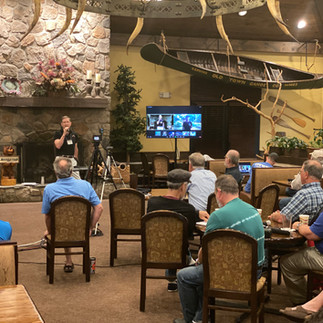How Technology Kept This Brotherhood Connected
- NCS Vinebranch
- Jul 15, 2021
- 3 min read
Updated: Dec 24, 2021
As the world grappled with how to continue bringing people together for meetings, NCS found itself having to adapt right along with it.
The birth of tech for NCS Winston Salem
At first, NCS continued to try to meet in person and use mobile phones to connect remote participants via Zoom. But as the virus worsened and everyone became more concerned about in-person gatherings, NCS made a quick pivot to 100% Zoom meetings. Thankfully, the group never missed a beat. Yet is was not without challenges.
Many phones that brothers were using lacked good video or audio quality, making it difficult for them to engage virtually. Through the initial part of this transition, some men fell out of fellowship with each other. As NCS faced new challenges, it found itself relying on more technology solutions delivered by Brandon Billings. The shift to virtual meetings required improved audio and video, with an upgraded camera and mic straight into Zoom. This worked until the need to play videos or share pictures arose, and Brandon found special software to accommodate the need.
The switch to hybrid
When North Carolina restrictions were lifted enough to allow in-person meetings on a limited basis, NCS jumped at the opportunity. With 25 men allowed to meet in person, the hybrid approach was born. But it, too, was not without challenges!
Brothers comfortable meeting in-person did so while everyone else stayed on Zoom. Now, not only did NCS need to present good quality video and audio to the Zoom participants but also bring the Zoom participants into the reality of an in-person meeting. The solution for this was to rent a 50" TV on a stand and a powered monitor for audio. The economics of this solution quickly presented the opportunity for NCS to purchase its own equipment and the tech assets grew once again.
Internet bandwidth had to be increased to generate a strong connection to Zoom. Camera settings had to be adjusted for picture quality, frame rate, light sensitivity and more. As well, NCS had to support the lower level of “tech savviness” of its typical brother. For some, simply logging into the meetings posed a challenge. The hybrid approach meant NCS would need to amplify the voice of the speaker in the room…and still feed the signal to Zoom. So, Brandon got a mixing board to improve the audio (more tech assets!).
In the meantime, we had AJ Britton with the Winston-Salem Fellows join us. He jumped in to assist wherever needed by setting up, hosting Zoom, etc. Later, Penn Clark took the task of creating overlays for any text needed on the screen (i.e. name labels). Then Josiah Van Rijn jumped in to help set up in the late spring just before the Fellows program ended. We began creating a small tech crew.
Lessons learned
So, what would the NCS tech crew say if they had to train up some brothers to do their jobs in five minutes?
1) Water flows downhill from its source to its endpoint – and so does signal flow. If there is no signal, start at the source and work through each piece of equipment, connection, cable, interface, etc. until you find what is preventing the "water" from getting to its endpoint.
2) There will always be potential distractions in the room that come just before "go-live", when nothing is working and you are restarting your computer. Stay focused, as it always comes together somehow.
3) When something fails, switch the webcam straight into Zoom. You will lose some quality but at least the meeting can go on. With the built-in microphone, you can also get audio. This will buy some time until you figure out what is not working as expected.
If anyone else would like to learn the tech…Billings is willing to train them! More hands make lighter work, and the end result is better for all.










Comments